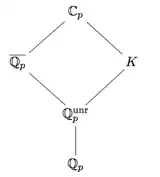Let $p$ be a prime number.
-
- What is the degree over $\Bbb Q_p$ of 'the' algebraic closure $\overline{\Bbb Q_p}$ of $\Bbb Q_p$ ?
-
- What is the order (the cardinality) of the absolute Galois group $G$ of $\Bbb Q_p$ ?
-
- What is the degree over $\overline{\Bbb Q_p}$ of the completion $\Bbb C_p$ of $\overline{\Bbb Q_p}$ ?
$ $
Here are some comments and thoughts :
1)
I know that $[\overline{\Bbb Q_p} : \Bbb Q_p] \geq \aleph_0$, since $X^n-p$ is irreducible in the UFD $\Bbb Z_p[X]$ for any $n \geq 1$. According to an answer here, we have $[\overline{\Bbb Q_p} : \Bbb Q_p] = \aleph_0$, but there is no proof of this claim.
Since $\Bbb Q_p$ has a unique unramified extension of degree $n$ for any $n \geq 1$, we have $[\Bbb Q_p^{\rm unr} : \Bbb Q_p] = \aleph_0$.
In general, we have $|k| =|k^{\rm sep}| = |\bar k|$, when $k$ is infinite (see here, exercise 4.5). But it doesn't help for knowing $[\bar k : k]$ (nor $[k^{\rm sep} : k]$, think of the separably closed but not algebraically closed field $\Bbb F_p(T)^{\rm sep}$). As mentioned here, we can have fields $k$ with $[\bar k : k] > \aleph_0$. In general, I think that we have $[\bar k : k] \leq |k|$ when $k$ is infinite. For any infinite field $k$ and any set $I$, we have $|k^{(I)}| = |k| \cdot |I| = \max(|k|, |I|)$ (where $\dim_k(k^{(I)}) = |I|$, while $\dim_k(k^{I}) = |k^I| = |k|^{|I|}$).
2)
Since $G$ surjects onto the absolute Galois group $\widehat{\Bbb Z}$ of $\Bbb F_p$, it is uncountable — I don't know if one can use a similar proof as for the absolute Galois group of $\Bbb Q$, using permutation of the square roots of primes, using this (maybe the fact that $\Bbb Q_p^{\times, 2}$ has finite index in $\Bbb Q_p^{\times}$ [$8$ if $p=2$ and $4$ if $p>2$] could be a problem?).
Moreover, $G$ is at most of cardinality $|\mathrm{Bij}(\overline{\Bbb Q_p})| = 2^{2^{\aleph_0}}$. So how to choose (assuming GCH...) between $2^{\aleph_0}$ and $2^{2^{\aleph_0}}$ for the cardinality of $G$ ?
3)
My question here asked about the degree of $\Bbb C_p$ over a completion of some subfield of $\overline{\Bbb Q_p}$, which is different from here. I know that $[\Bbb C_p : \overline{\Bbb Q_p}]>1$, but it is not obvious to me that this degree is $\geq \aleph_0$. (By the way, we have $|\Bbb C_p| = 2^{\aleph_0}$ by exercise 2.30.5 here).
According to Arithmetic of Algebraic Curves (Stepanov), p. 239(d), the transcendence degree of $\Bbb C_p$ over $\overline{\Bbb Q_p}$ is already $2^{\aleph_0}$, without proof. I'm not sure how to prove this, and actually I should think to the relation between $\mathrm{tr.deg}_k(L)$ and $[L:k]$ : if $B$ is a transcendence basis of $L$ over an infinite field $k$, then we have $$|k| \cdot |B| = [k(B) : k] \leq [L:k] \leq [\overline{k(B)} : k] \leq |k| \cdot |B| \cdot |k(B)| = (|k| \cdot |B| ) \cdot (|k| \cdot |B|)$$ In particular, if $|B| = \mathrm{deg.tr}_k(L) = 2^{\aleph_0} = |k|$, then we get $[L:k] = 2^{\aleph_0}$ (see also 11.4 here...).
Thank you for your various comments!
